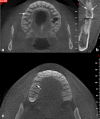Cone-beam CT evaluation of root canal morphology of maxillary and mandibular premolars in a Turkish Cypriot population
- PMID: 29607060
- PMCID: PMC5831013
- DOI: 10.1038/bdjopen.2015.6
Cone-beam CT evaluation of root canal morphology of maxillary and mandibular premolars in a Turkish Cypriot population
Abstract
Objectives: Because of economic and political issues, Turkish Cypriots have been emigrating from Cyprus since the 1920s, especially to the United Kingdom, other European countries and Australia. Recently, according to the UK House of Commons, Home Affairs Committee, ~300,000 Cypriot Turks were living in the United Kingdom. However, this ethnic population residing in the United Kingdom has been insufficiently analysed. Although many Turkish Cypriots have been living abroad, little is known about the dental characteristics of this group. Premolar teeth, especially maxillary premolars, pose great challenges in endodontic treatment because of the number of roots and canals, and the variation in the configurations of the pulp cavity. Thus, it was considered valuable to determine the morphological characteristic of premolar teeth in a Turkish Cypriot population to aid clinicians in performing endodontic treatment in this ethnic population.
Materials and methods: The sample for this cross-sectional study consisted of a retrospective evaluation of cone-beam CT scans of 263 adult patients (age range 16-80 years). The number of roots and their morphology, the number of canals per root and the canal configuration were examined. The root canal configurations were also classified according to the scheme of Vertucci in the maxillary and mandibular premolar teeth. Pearson's χ2-test was performed among canal configurations, sides and gender (P⩽0.05).
Results: In the present study, most root canal configurations were type IV (76.8%) and type I (49.4%) in the maxillary first and second premolars, respectively, whereas most root canal configurations were type I (93%) in both mandibular first and second premolars. In total, four (0.9%) teeth in the maxillary first premolars and two (0.4%) teeth in the maxillary second molar premolars had three roots.
Conclusions: This is the first population-based study to focus solely on Turkish Cypriots' root canal anatomy. Our findings will be valuable for dental professionals who treat many Turkish Cypriot patients, in the United Kingdom, Australia and other countries.
Conflict of interest statement
The authors declare no conflict of interest.
Figures


Similar articles
-
A cone-beam computed tomography study of root canal morphology of maxillary and mandibular premolars in a Turkish population.Acta Odontol Scand. 2014 Nov;72(8):701-6. doi: 10.3109/00016357.2014.898091. Epub 2014 May 15. Acta Odontol Scand. 2014. PMID: 24832561
-
Evaluation of root morphology and root canal configuration of premolars in the Turkish individuals using cone beam computed tomography.Eur J Dent. 2015 Oct-Dec;9(4):551-557. doi: 10.4103/1305-7456.172624. Eur J Dent. 2015. PMID: 26929695 Free PMC article.
-
Assessment of the canal anatomy of the premolar teeth in a selected Turkish population: a cone-beam computed tomography study.BMC Oral Health. 2023 Jun 19;23(1):403. doi: 10.1186/s12903-023-03107-7. BMC Oral Health. 2023. PMID: 37337200 Free PMC article.
-
Evaluation of root canal morphology of human primary molars by using CBCT and comprehensive review of the literature.Acta Odontol Scand. 2016;74(4):250-8. doi: 10.3109/00016357.2015.1104721. Epub 2015 Nov 2. Acta Odontol Scand. 2016. PMID: 26523502 Review.
-
Root and canal morphology of maxillary first premolars in a Saudi population.J Contemp Dent Pract. 2008 Jan 1;9(1):46-53. J Contemp Dent Pract. 2008. PMID: 18176648 Review.
Cited by
-
Morphological Evaluation of Maxillary Premolar Canals in Iranian Population: A Cone-Beam Computed Tomography Study.J Dent (Shiraz). 2020 Sep;21(3):215-224. doi: 10.30476/DENTJODS.2020.82299.1011. J Dent (Shiraz). 2020. PMID: 33062816 Free PMC article.
-
Root canal morphology of the mandibular second premolar: a systematic review and meta-analysis.BMC Oral Health. 2021 Jun 16;21(1):309. doi: 10.1186/s12903-021-01668-z. BMC Oral Health. 2021. PMID: 34134669 Free PMC article.
-
Cone-Beam Computed Tomographic Evaluation of Root Canal Morphology of Maxillary Premolars in a Saudi Population.Biomed Res Int. 2018 Aug 15;2018:8170620. doi: 10.1155/2018/8170620. eCollection 2018. Biomed Res Int. 2018. PMID: 30186867 Free PMC article.
-
Surgically-oriented anatomical study of mandibular premolars: A CBCT study.J Clin Exp Dent. 2019 Oct 1;11(10):e877-e882. doi: 10.4317/jced.55848. eCollection 2019 Oct. J Clin Exp Dent. 2019. PMID: 31636856 Free PMC article.
-
Maxillary Permanent First Premolars With Three Canals: Incidence Analysis Using Cone Beam Computerized Tomographic Techniques.J Pharm Bioallied Sci. 2019 May;11(Suppl 2):S474-S480. doi: 10.4103/JPBS.JPBS_89_19. J Pharm Bioallied Sci. 2019. PMID: 31198390 Free PMC article.
References
-
- Carns EJ , Skidmore AE . Configurations and deviations of root canals of maxillary first premolars. Oral Surg Oral Med Oral Pathol 1973; 36: 880–886. - PubMed
-
- Loh HS . Root morphology of the maxillary first premolar in Singaporeans. Aust Dent J 1998; 43: 399–402. - PubMed
-
- Pecora JD , Saquy PC , Sousa Neto MD , Woelfel JB . Root form and canal anatomy of maxillary first premolars. Braz Dent J 1992; 2: 87–94. - PubMed
-
- Vertucci FJ , Gegauff A . Root canal morphology of the maxillary first premolar. J Am Dent Assoc 1979; 99: 194–198. - PubMed
LinkOut - more resources
Full Text Sources
Other Literature Sources
Medical

